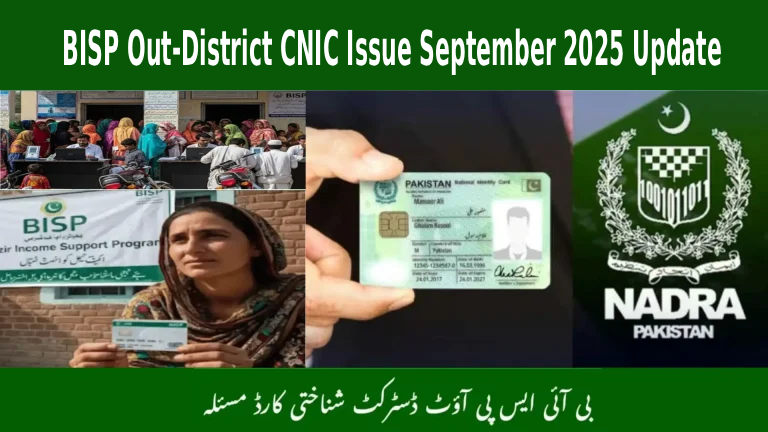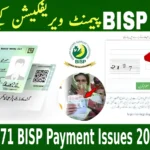
Introduction paragraph:
The BISP Out-District CNIC issue is a pressing concern for many beneficiaries in September 2025 as it affects their ability to receive the much-needed Rs. 13,500 financial assistance. Many women and other recipients face hurdles because their CNIC addresses do not match the district where they attempt to collect their installment. Understanding this issue and how to handle it can save time and avoid frustration for BISP beneficiaries.
What is the BISP Out-District CNIC Issue September 2025?
The BISP Out-District CNIC issue occurs when a beneficiary’s CNIC registration is flagged as being from a different district than where they try to collect their BISP installment. This mismatch in district data leads to payment delays or rejection of the installment by the system. In September 2025, despite the government releasing Rs. 13,500 payments, beneficiaries with out-district CNICs often face problems in accessing their funds, especially in cities like Lahore.
Why Does the Out-District CNIC Problem Happen?
This issue arises due to the Benazir Income Support Programme’s strict rules that restrict beneficiaries to collect their funds only in their registered CNIC districts. The system is designed to avoid fraud and ensure payments go to the correct recipients. However, internal migration, marriages, and other life events can cause mismatches between the CNIC address and the actual district where the beneficiary now lives or tries to collect payment.
How to Check Your BISP CNIC Status for September 2025
To avoid surprises, beneficiaries should check their CNIC status and district registration before attempting to claim their installment. This can be done quickly by:
- Sending your CNIC number via SMS to the official BISP short code 8171
- Using the official BISP online portal or other authorized websites for CNIC verification
This helps in confirming if your CNIC is properly registered and whether you are eligible for the payment under the current district rollout plan.
Steps to Resolve the Out-District CNIC Issue
If your CNIC is flagged as out-district, you can take the following actions:
- Contact the nearest BISP office for assistance regarding updating your CNIC district address.
- Verify your information through biometric verification points authorized by BISP if your payment is delayed due to mismatches.
- Follow up regularly on official helplines or SMS services to track your payment status.
- Keep your CNIC details up to date with NADRA, ensuring your current address reflects your residence.
District-Wise BISP Payment Rollouts and Its Impact
BISP payments in 2025, including September’s disbursement, are released district-wise to streamline distribution and cut down fraud. If your district has not started its rollout phase, your payment will be pending, adding to the confusion if you try to collect out of your registered district. This system requires patience and attentiveness to official announcements from BISP.
How Biometric Verification Influences Payment
Biometric verification, mainly fingerprint scans, plays a crucial role in confirming beneficiary identity before releasing BISP payments. Problems with biometric data, such as mismatched fingerprints or outdated records, often cause delayed or blocked payments. Ensuring your biometric data is updated and verified at official centers can prevent payment interruptions.
The Role of 8171 SMS Service in Managing CNIC Issues
The 8171 SMS service is a vital tool for beneficiaries to:
- Quickly check their CNIC registration and payment status
- Receive alerts about biometric verification and district registration status
- Get official guidance on resolving out-district CNIC problems
Using this service regularly helps beneficiaries stay informed and take timely corrective actions.
What to Expect Next: BISP’s Efforts to Address CNIC Issues
BISP authorities are aware of the out-district CNIC challenges and are working on improving system flexibility and data accuracy. Updates in January 2026 may include easier address updates and wider biometric verification access to reduce these hurdles for beneficiaries.
FAQ Section
Q1: What is the BISP Out-District CNIC issue?
A1: It is when a beneficiary’s CNIC registered district does not match the district where they try to collect their BISP installment, causing payment delays or denials.
Q2: How can I check if my CNIC is registered for BISP?
A2: You can check by sending your CNIC number to 8171 via SMS or by visiting the official BISP online portal for verification.
Q3: Can I collect my BISP payment from a different district than my CNIC address?
A3: Normally, no. BISP payments are district-specific to avoid fraud, so out-district collections often face problems.
Q4: What should I do if my BISP payment is delayed due to out-district CNIC?
A4: Contact the nearest BISP office, update your CNIC address with NADRA if needed, and verify your biometric data at designated centers.
Q5: How does biometric verification affect BISP payments?
A5: Biometric verification confirms the beneficiary’s identity before releasing funds. Issues with fingerprints can delay or block payments until resolved.
Conclusion
The BISP Out-District CNIC issue September 2025 update highlights ongoing challenges many beneficiaries face in receiving their rightful Rs. 13,500 installment on time. Understanding the problem, checking CNIC registration via 8171 SMS or online portals, and taking steps to update addresses and biometric data are essential to avoid payment hurdles. Staying informed about district-wise payment rollouts and using official resources will help beneficiaries navigate the process smoothly. With continuous improvements expected from BISP, these issues may be resolved more efficiently in future cycles.

